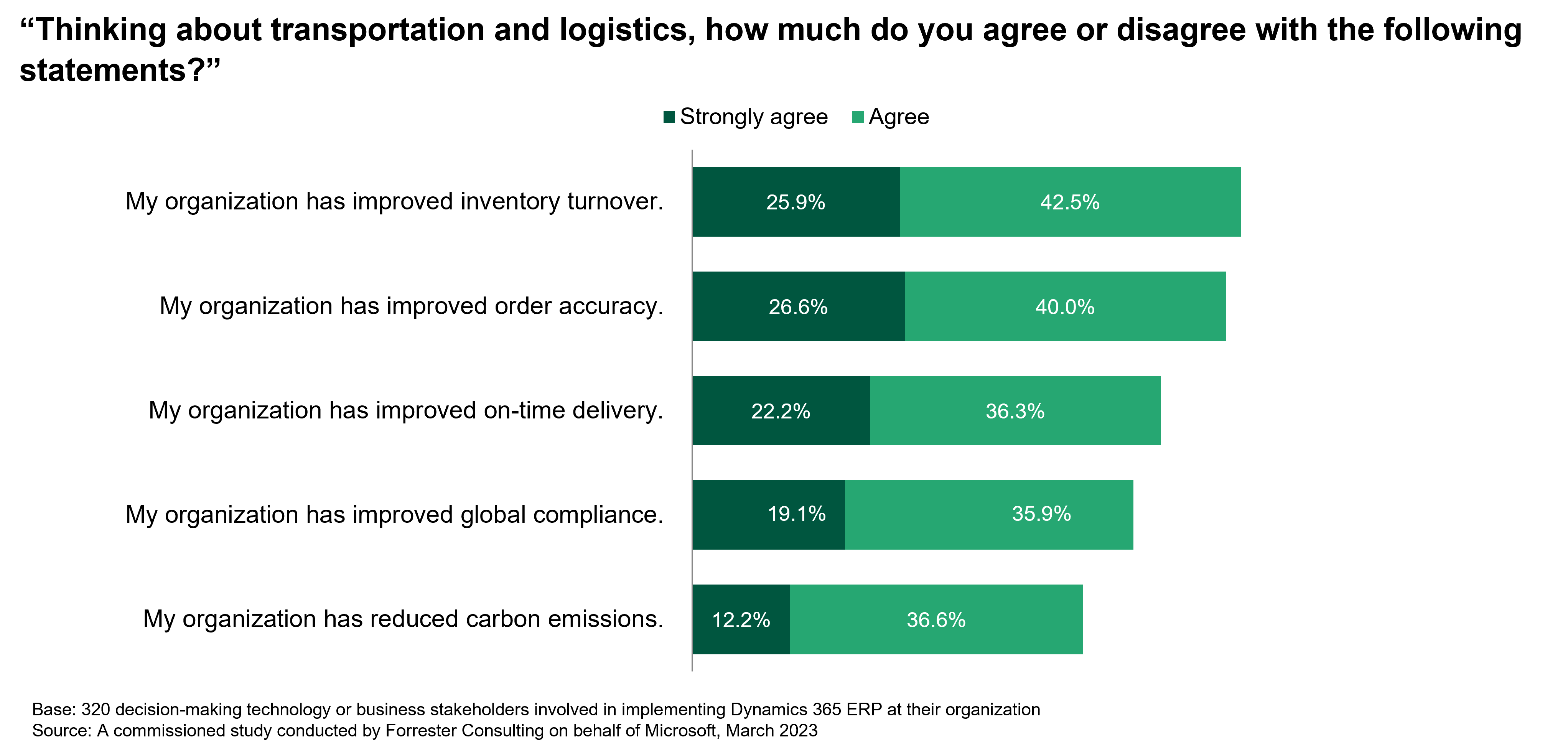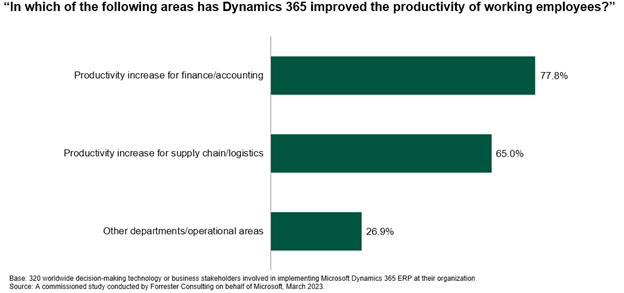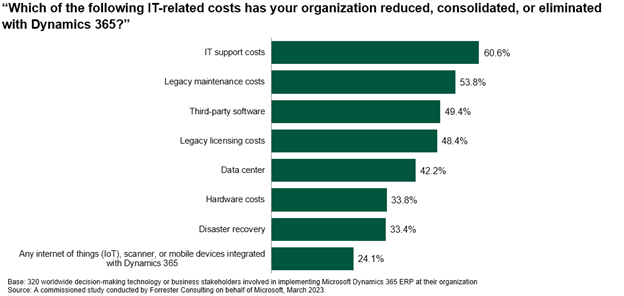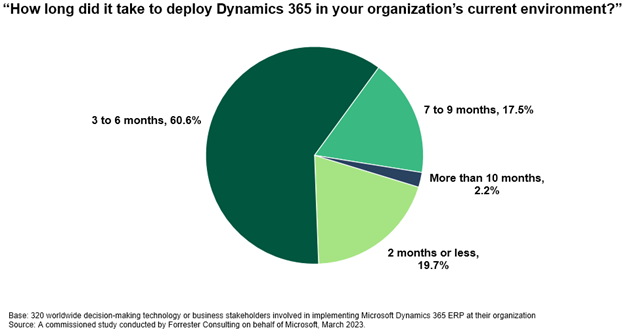The Total Economic Impact™ Of Microsoft Dynamics 365 ERP
Cost Savings And Business Benefits Enabled By Dynamics 365 ERP
A Forrester Total Economic Impact™ Study Commissioned By Microsoft, March 2024
Organizations grappling with fragmented operations and suboptimal decision-support mechanisms increasingly can turn towards implementing a cloud-based ERP system and the integration of finance and supply chain functions to strategically address these issues. This approach promotes efficiency and scalability while transcending departmental, geographical, and divisional boundaries. A solution that consolidates data, automates workflows, reduces reliance on disparate systems, and provides instant access to essential insights is indispensable for companies seeking to navigate market fluctuations, streamline processes, achieve additional growth, and enhance overall success.
Microsoft Dynamics 365 offers a cloud-based ERP solution with Dynamics 365 Finance and Dynamics 365 Supply Chain Management in an integrated platform that offers significant benefits by centralizing and streamlining data and processes, enhancing efficiency, and improving decision-making through real-time insights. Specifically, Dynamics 365 optimizes supply chain and financial workflows, improves the accuracy of analyses and reports, and enhances productivity across various departments. Furthermore, it diminishes the need for extensive IT infrastructure and support directed toward legacy on-premises systems as well as reliance on internal data centers and disaster recovery solutions, and it lowers costs associated with overhead. The agility afforded by Dynamics 365 may allow businesses to respond more effectively to market changes and customer demands, which can foster increased profitability and competitive advantage.
Microsoft commissioned Forrester Consulting to conduct a Total Economic Impact™ (TEI) study and examine the potential return on investment (ROI) enterprises may realize by deploying Dynamics 365.1 The purpose of this study is to provide readers with a framework to evaluate the potential financial impact of Dynamics 365 on their organizations.
To better understand the benefits, costs, and risks associated with this investment, Forrester interviewed five IT leaders at four organizations and surveyed another 320 professionals with experience using Dynamics 365. For the purposes of this study, Forrester aggregated the interviewees’ experiences and combined the results into a single composite organization that has 5,000 employees and generates $1 billion in annual revenue.
Interviewees said that prior to using Dynamics 365, their organizations struggled with siloed data scattered across multiple, disparate legacy systems. This required excessive manual efforts to collect, process, analyze, and report accurate and timely analytics and results, which created companywide drags on performance. Inflexible legacy systems also constrained projected savings in growth opportunities and raised cybersecurity vulnerabilities with multiple systems and solutions that were not always kept up to date with adequate maintenance. Prior attempts to address these challenges often resulted in additional costs for more services or solutions attempting to create bespoke, half-baked integrations that only yielded ineffective stopgaps.
The interviewees and survey respondents reported that after the investment in Dynamics 365, their organizations saw widespread improvements that impacted finance and supply chain processes and beyond.
Key Findings
Quantified benefits. Three-year, risk-adjusted present value (PV) quantified benefits for the composite organization include:
- Increased profitability from real-time visibility and enhanced decision-making. Dynamics 365 fosters greater operational agility and improvements for the composite organization in accounts receivable, collections inventory, inventory turnover, order accuracy, on-time delivery, and the management of accounts payable. This pushes the value of this benefit for the composite to more than $1.2 million over three years.
- Increased productivity from unified data access, streamlined processes, automated workflows, and other gained efficiencies. The composite organization’s key personnel working in finance, accounting, supply chain, logistics, and other roles save between seven and 15 hours per week with Dynamics 365. This benefit is worth $8.9 million to the composite over three years.
- Reduced infrastructure and IT operations spend from cloud migration. The composite organization offloads or significantly reduces numerous cost centers associated with on-premises legacy solutions including IT support, disaster recovery, data center, hardware, maintenance, and third-party software along with internet-of-things (IoT), scanner, and mobile devices. This benefit is worth $3.9 million to the composite over three years.
- Cost savings from organizational simplification. By deploying Dynamics 365, the composite organization sees impact to other cost centers including overhead and professional services. It also enables substantial savings from the unification of offices, regions, subsidiaries, or acquisitions. In total, this benefit is worth $1.8 million to the composite over three years.
Unquantified benefits. Benefits that provide value for the composite organization but are not quantified for this study include:
- Enhanced employee experience. Dynamics 365 offers the composite greater stability and better performance than legacy solutions, and it lessens the amount of mundane and tedious work required of end users.
- Improved cybersecurity posture. Having fewer on-premises systems and shifting management and maintenance duties to Microsoft decreases the amount and severity of cybersecurity vulnerabilities the composite sees.
Costs. Three-year, risk-adjusted PV costs for the composite organization include:
- Subscription fees. The composite pays a total of $4.4 million over three years for user subscriptions that are based on per-user, per-month fees.
- Implementation and ongoing administration. To implement Dynamics 365, the composite utilizes internal effort from IT and business personnel as well as assistance from a systems integrator that also provides ongoing support. These costs total $3.2 million for the composite over three years.
The representative interviews, survey, and financial analysis found that a composite organization experiences benefits of $15.8 million over three years versus costs of $7.7 million, adding up to a net present value (NPV) of $8.1 million and an ROI of 106%.



Key Statistics
-
Return on investment (ROI)
106%
-
Benefits PV
$15.77M
-
Net present value (NPV)
$8.10M
-
Payback
17 months
Benefits (Three-Year)
Increased profitability Increased productivity Reduced infrastructure and IT operations spend from cloud migration Cost savings from organizational simplificationTEI Framework And Methodology
From the information provided in the interviews, Forrester constructed a Total Economic Impact™ framework for those organizations considering an investment Dynamics 365.
The objective of the framework is to identify the cost, benefit, flexibility, and risk factors that affect the investment decision. Forrester took a multistep approach to evaluate the impact that Dynamics 365 can have on an organization.
-
Due Diligence
Interviewed Microsoft stakeholders and Forrester analysts to gather data relative to Dynamics 365.
-
Interviews And Survey
Interviewed five IT leaders at four organizations and surveyed 320 other professionals at organizations using Dynamics 365 to obtain data about costs, benefits, and risks.
-
Composite Organization
Designed a composite organization based on characteristics of the interviewees’ and survey respondents’ organizations.
-
Financial Model Framework
Constructed a financial model representative of the interviews using the TEI methodology and risk-adjusted the financial model based on issues and concerns of the interviewees and survey respondents.
-
Case Study
Employed four fundamental elements of TEI in modeling the investment impact: benefits, costs, flexibility, and risks. Given the increasing sophistication of ROI analyses related to IT investments, Forrester’s TEI methodology provides a complete picture of the total economic impact of purchase decisions. Please see Appendix A for additional information on the TEI methodology.
Disclosures
Readers should be aware of the following:
This study is commissioned by Microsoft and delivered by Forrester Consulting. It is not meant to be used as a competitive analysis.
Forrester makes no assumptions as to the potential ROI that other organizations will receive. Forrester strongly advises that readers use their own estimates within the framework provided in the study to determine the appropriateness of an investment in Dynamics 365.
Microsoft reviewed and provided feedback to Forrester, but Forrester maintains editorial control over the study and its findings and does not accept changes to the study that contradict Forrester’s findings or obscure the meaning of the study.
Microsoft provided the customer names for the interviews but did not participate in the interviews.
Consulting Team:
Kris Peterson
Nahida Nisa
Drivers leading to the Dynamics 365 investment
Key Challenges
The interviewees noted how their organizations struggled with common challenges, including:
- Alignment of ERP with digital transformation initiatives. Interviewees discussed organizational objectives around migrating business applications to the cloud. The vice president in energy said: “We had a digital transformation strategy to move to cloud-based solutions and get away from on-prem, and then we were looking … to deploy additional functionality into some of areas that we historically hadn’t automated on a common platform.”
- Legacy ERP solutions constrained organizational performance and growth. Legacy ERP solutions had reached end-of-life status, fallen out of support, or were so heavily customized that they could not accommodate any additional organizational change or growth. The head of delivery and innovation in agriculture discussed the effect of multiple siloed systems in place as a result of numerous mergers and acquisitions: “In terms of the organization seeking synergies and benefits from the merger, the systems were an inhibitor to doing that. … It also limited what we could do in the space of electronic commerce or any kind of modern electronic interactions. [We also had] to source raw data from lots of places and try and munge it together.”
-
Legacy ERP solutions increased security vulnerabilities. The vice president of IT in manufacturing/construction explained: “In today’s world, the other significant thought is, ‘Where are any of these assets regarding cybersecurity risks?’ … Being on old software at any level in the stack is a greater cybersecurity risk because we can’t just get good virus protection, patch maintenance, and those sorts of things for old operating systems.”
They continued: “[The legacy solution] had been very heavily customized to the point that it wasn’t upgradable. These other systems we were using were nonscalable [and] not really able to grow and do any of these other tasks.”
The senior director of IT in healthcare/life sciences discussed business requirements for their organization as it considered a strategic shift during the COVID-19 pandemic: “As we started working with some different specialty labs, [they have] different ERP solutions that when we try to scale with [the legacy ERP], it can be complex because of the customization within our overall core ERP platform. … The business use case was to find an ERP solution that’s scalable and has some familiarity with similar workloads across the B2B relationships that we have in scope.”

Composite Organization
Based on the interviews and survey, Forrester constructed a TEI framework, a composite company, and an ROI analysis that illustrates the areas financially affected. The composite organization is representative of the five interviewees and the 320 survey respondents, and it is used to present the aggregate financial analysis in the next section. The composite organization has the following characteristics:
Description of composite. The composite organization generates $1 billion of annual revenue with 5,000 employees distributed across numerous locations. It has operated with a patchwork of disparate legacy ERP systems, each catering to different regions, divisions, and aspects of the business, such as finance, supply chain management, and other operational areas. The legacy solutions were siloed, which led to inefficiencies in data sharing and process integration and required significant manual intervention to reconcile information across departments. The organization relied heavily on on-premises hardware and data centers, which led to substantial costs in maintenance, IT support, and disaster recovery efforts. The need to integrate with various third-party software for extended functionalities (e.g., IoT integration, mobile device management, analytics) further amplified operational costs and complexity. The lack of a unified system also made it challenging to consolidate business processes across offices, regions, subsidiaries, or after acquisitions, which led to inconsistencies in data and processes, higher professional service costs for audits and compliance, and an overall lack of agility and scalability in responding to market changes.
Deployment characteristics. The composite organization deploys Microsoft Dynamics 365 ERP with finance and supply chain modules in a phased implementation that is fully integrated in nine months.
Quantified benefit data as applied to the composite
Total Benefits
| Ref. | Benefit | Year 1 | Year 2 | Year 3 | Total | Present Value |
|---|---|---|---|---|---|---|
| Atr | Increased profitability | $270,000 | $540,000 | $675,000 | $1,485,000 | $1,198,873 |
| Btr | Increased productivity | $1,236,098 | $4,944,394 | $4,944,394 | $11,124,886 | $8,924,798 |
| Ctr | Reduced infrastructure and IT operations spend from cloud migration | $535,275 | $2,141,100 | $2,141,100 | $4,817,475 | $3,864,758 |
| Dtr | Cost savings from organizational simplification | $246,825 | $987,300 | $987,300 | $2,221,425 | $1,782,110 |
| Total benefits (risk-adjusted) | $2,288,198 | $8,612,794 | $8,747,794 | $19,648,786 | $15,770,539 | |
Increased Profitability
Evidence and data. Study participants said implementing Dynamics 365 led to real-time visibility into operations and financials, better informed and expedited decision-making, and increased operational agility in a competitive marketplace. They noted improvements in accounts receivable, collections inventory, inventory turnover, order accuracy, on-time delivery, and the management of accounts payable. These improvements helped with stock level optimization, improved demand forecasting, and reduced excess inventory, while more efficient order processing led to faster fulfillment and enhanced supplier collaboration.
- Eighty-one percent of survey respondents indicated that Dynamics 365 makes it easier to provide executives with reporting and analysis. They also reported their organizations reduced the time required for these activities by 39% on average.
- Fifty percent of respondents reported annual profitability increases between $250,000 and $750,000, and 29.4% reported annual increases of more than $750,000.
- The average profitability increase reported by survey respondents was $545,100, with the most common profitability improvements related to streamlined processes and associated reductions in costs and efforts needed for customer support, managing and submitting orders, retail operations, maintaining catalogs, and marketing efforts.
- The IT director in manufacturing/construction said, “[Dynamics 365] gives you an ability to better track your costs and understand which products and products lines are more profitable.”
- The senior director of IT in healthcare/life sciences said: “From a supply-chain standpoint, when it comes to looking at a procurement process … [and] to be able to do that process because it is centralized instead of having different types of silos and systems of record [is] absolutely a [driver of] cost savings.”
- The vice president in energy explained: “Having an AP (accounts payable) aging report and an AR (accounts receivable) aging report that’s reliable and consistent across the company was important. It also highlighted the troubled areas so [finance] could focus their efforts on either collecting from the customers we know are notorious for being late versus chasing everyone because you knew the ones that were going to pay and not pay. So, that’s been helpful. Understanding our AP exposure [has] gotten a lot better, and how we pay our vendors has improved with that visibility.”

Modeling and assumptions. Based on the interviews and survey, Forrester assumes the following about the composite organization:
- The composite’s annual revenue is $1 billion.
- The composite’s profit margin is 10%.
- The composite’s profitability increases by 0.30% in Year 1, by 0.60% in Year 2, and by 0.75% in Year 3.
Risks. This benefit can vary across organizations depending on:
- The industry the company operates in, which impacts the level of revenue and gross margin realized.
- The complexity of the overall business and the type of analytics that can be integrated into operational processes.
- The experience and skill sets of the organization’s people and the quality of its processes.
Results. To account for these risks, Forrester adjusted this benefit downward by 10%, yielding a three-year, risk-adjusted total PV (discounted at 10%) of $1.2 million.
Increased Profitability
| Ref. | Metric | Source | Year 1 | Year 2 | Year 3 | |
|---|---|---|---|---|---|---|
| A1 | Revenue | Composite | $1,000,000,000 | $1,000,000,000 | $1,000,000,000 | |
| A2 | Profit margin | TEI standard | 10% | 10% | 10% | |
| A3 | Profitability increase attributable to Dynamics 365 ERP from real-time visibility and enhanced decision making | Survey | 0.30% | 0.60% | 0.75% | |
| At | Increased profitability | A1*A2*A3 | $300,000 | $600,000 | $750,000 | |
| Risk adjustment | ↓10% | |||||
| Atr | Increased profitability (risk-adjusted) | $270,000 | $540,000 | $675,000 | ||
| Three-year total: $1,485,000 | Three-year present value: $1,198,873 | |||||
Increased Productivity
Evidence and data. Study participants said using Dynamics 365 saves the time and effort of personnel in finance, accounting, supply chain, logistics, and other areas through unified data access, streamlined processes, and ease of use. They explained that automating routine tasks improved accuracy of analytics and reporting by reducing manual data entry and errors and that Dynamics 365 reduced efforts around cross-departmental workflows, inventory management, compliance management, closing cycles, and audit processes. Interviewees also said Dynamics 365 is easy to learn and use because of the similarity of its commands, navigation, and functionality to other Microsoft applications.
- Survey respondents reported that finance and accounting employees save 14.5 hours per week, supply chain and logistics employees save 8.7 hours per week, and other employees save 7.4 hours per week.
- Participants most frequently cited automation, system access and data integration across business units and sites, business intelligence analytics and dashboards, and Microsoft integrations with solutions like Office and Azure as the features that drove productivity gains.

-
The vice president in energy explained: “Historically, it was all segregated data, multiple systems, and multiple applications trying to do consolidations, [and it] was very difficult. Our … nonquarter-end close used to be about 20 days. We got that down to about seven days. Quarter ends for SEC (Securities and Exchange Commission) reporting [have] gone down to 14 days from about 28 days. … Just having data in one location and all the functionality in one location has been beneficial. … We’ve been able to deploy common processes and procedures to all divisions regardless of their focus and vertical. Manufacturing has the same chart of accounts and same general ledger and same processes to complete their AP and AR and payments. … All that data comes into one view, so we’ve now been able to leverage that to build some pretty robust dashboards to manage our business pretty tightly. … It’s been a significant improvement.”
The interviewee continued: “Our scalability has gotten exponentially better, so even though our business has grown and we’ve brought in a lot of customers and our volume has grown and our revenue has grown, we haven’t really staffed like we would in the past because the automation has afforded us to scale better in the back office.”
- The vice president of IT in manufacturing/construction said: “Microsoft … [has] vetted very valuable functionality. … When the data displays in a grid fashion, you’ll see an Office icon light up that will say Excel is an option. You just click on it, and then you can export that data into Excel, edit it there, and then Excel updates the production ERP database.”
-
The senior director of IT in healthcare/life sciences said: “The ability to integrate across different types of Microsoft products and services along with the familiarity of end users being comfortable using Microsoft products and services and the [associated] functionality … removes a lot of redundancy and challenges.”
The interviewee added: “[Automation] takes out a lot of the manual processes. … It does help speed up a lot of mundane tasks, and now you’re looking at more actionable data [from which] you can build models and forecasting.”
Modeling and assumptions. Based on the interviews and survey, Forrester assumes the following about the composite organization:
- Using Dynamics 365 saves 50 finance and accounting employees 14.5 hours per week.
- The fully burdened average hourly salary of a finance and accounting employee is $60.
- Using Dynamics 365 saves 250 supply chain and logistics employees 8.7 hours per week.
- The fully burdened average hourly salary of a supply chain and logistics employee is $60.
- Using Dynamics 365 saves 50 other employees 8.7 hours per week.
- The fully burdened average hourly salary of the 50 other employees is $63.
- Employees redirect 50% of the time saved toward other value-added tasks.
- Using a phased implementation in Year 1 allows the composite to achieve 25% of the annual benefit amount.
Risks. Productivity improvements can vary across organizations due to differences in:
- The organization’s prior state of technology, processes, business insight capabilities, and level of change in day-to-day activities that occur with the deployment of Dynamics 365.
- The skill and capacity of the organization’s personnel whose day-to-day activities are impacted by Dynamics 365.
Results. To account for these risks, Forrester adjusted this benefit downward by 5%, yielding a three-year, risk-adjusted total PV (discounted at 10%) of $8.9 million.
Increased Productivity
| Ref. | Metric | Source | Year 1 | Year 2 | Year 3 | |
|---|---|---|---|---|---|---|
| B1 | Finance and accounting employees reliant on manual and other inefficient processes and systems prior to Dynamics 365 | Composite | 50 | 50 | 50 | |
| B2 | Time saved per week from automated tasks, streamlined processes, and enhanced compliance management (hours) | Survey | 14.5 | 14.5 | 14.5 | |
| B3 | Fully burdened average hourly salary of a finance and accounting team member | TEI standard | $60 | $60 | $60 | |
| B4 | Subtotal: Finance and accounting productivity improvements | B1*B2*B3*50 | $2,175,000 | $2,175,000 | $2,175,000 | |
| B5 | Supply chain and logistics employees reliant on manual and other inefficient processes and systems prior to Dynamics 365 | Composite | 250 | 250 | 250 | |
| B6 | Time saved per week from improved inventory management, demand forecasting, and more efficient order processing (hours) | Survey | 8.7 | 8.7 | 8.7 | |
| B7 | Fully burdened average hourly salary of a supply chain or logistics team member | TEI standard | $65 | $65 | $65 | |
| B8 | Subtotal: Supply chain and logistics productivity improvements | B5*B6*B7*50 | $7,068,750 | $7,068,750 | $7,068,750 | |
| B9 | Other employees with workflows impacted by Dynamics 365 | Composite | 50 | 50 | 50 | |
| B10 | Time saved per week from unified data access, automated workflows, and enhanced collaboration tools (hours) | Survey | 7.4 | 7.4 | 7.4 | |
| B11 | Fully burdened average hourly salary of other employees | TEI standard | $63 | $63 | $63 | |
| B12 | Subtotal: Other employee productivity improvements | B9*B10*B11*50 | $1,165,500 | $1,165,500 | $1,165,500 | |
| B13 | Productivity recapture | TEI standard | 50% | 50% | 50% | |
| B14 | Ramp-up period | TEI standard | 25% | 100% | 100% | |
| Bt | Increased productivity | (B1*B2*B3)*B13*B14 | $1,301,156 | $5,204,625 | $5,204,625 | |
| Risk adjustment | ↓5% | |||||
| Btr | Increased productivity (risk-adjusted) | $1,236,098 | $4,944,394 | $4,944,394 | ||
| Three-year total: $11,124,886 | Three-year present value: $8,924,798 | |||||
Reduced Infrastructure And IT Operations Spend From Cloud Migration
Evidence and data. Study participants reported that deploying the cloud-based Dynamics 365 allowed their organizations to migrate away from legacy on-premises solutions, which reduced related expenditures and offloaded a variety of internal efforts. They said expenditures for purchasing, supporting, and maintaining on-premises solutions, servers, hardware, and third-party systems decreased and built-in disaster recovery and business continuity features diminished the need for expensive disaster recovery plans and infrastructure.
Participants also explained that their organizations reduced or eliminated expenses associated with maintaining physical data centers, including the costs of space, electricity, and cooling. Other reductions noted included costs associated with IoT, scanner, and mobile device functionalities, which respondents said are easily integrated with Dynamics 365 and reduces the need for expensive third-party solutions and custom integrations.
- Survey respondents most frequently cited IT support as a cost reduction, with 60.6% saying their organization realizes this benefit. Cost reductions related to maintenance efforts and third-party software were the next most common benefits.
- Survey respondents provided estimates of reduced costs attributable to Dynamics 365 ERP, including costs related to IT support, disaster recovery, data center, hardware, maintenance, third-party software, and IoT, scanner, and mobile devices. Average annual savings for the various categories ranged from $212,000 to $505,000.

Modeling and assumptions. Based on the interviews and survey, Forrester assumes the following about the composite organization:
- With Dynamics 365, the composite reduces its IT support costs by $440,000 annually.
- The composite reduces its disaster recovery costs by $267,000 annually.
- The composite reduces its data center costs by $359,000 annually.
- The composite reduces its hardware costs by $313,000 annually.
- The composite reduces its maintenance efforts by $283,000 annually when compared to what was needed for legacy solutions.
- The composite reduces its third-party software costs by $505,000 annually.
- The composite reduces its IoT, scanner, and mobile device costs by $212,000 annually.
- Using a phased implementation in Year 1 allows the composite to achieve 25% of the annual benefit amount.
Risks. The value of this benefit can vary across organizations due to differences in:
- The configuration and complexity of the organization’s legacy infrastructure solutions.
- The nature of the organization’s prior IT support costs.
Results. To account for these risks, Forrester adjusted this benefit downward by 10%, yielding a three-year, risk-adjusted total PV (discounted at 10%) of $3.9 million.
Reduced Infrastructure And IT Operations Spend From Cloud Migration
| Ref. | Metric | Source | Year 1 | Year 2 | Year 3 |
|---|---|---|---|---|---|
| C1 | Reduced IT support costs | Survey | $440,000 | $440,000 | $440,000 |
| C2 | Reduced disaster recovery costs | Survey | $267,000 | $267,000 | $267,000 |
| C3 | Reduced data center costs | Survey | $359,000 | $359,000 | $359,000 |
| C4 | Reduced hardware costs | Survey | $313,000 | $313,000 | $313,000 |
| C5 | Reduced maintenance efforts compared to legacy solutions | Survey | $283,000 | $283,000 | $283,000 |
| C6 | Reduced third-party software costs | Survey | $505,000 | $505,000 | $505,000 |
| C7 | Reduced IoT, scanner, and mobile device costs | Survey | $212,000 | $212,000 | $212,000 |
| C8 | Ramp-up period | Composite | 25% | 100% | 100% |
| Ct | Reduced infrastructure and IT operations spend from cloud migration | (C1+C2+C3+C4+C5+C6+C7 )*C8 | $594,750 | $2,379,000 | $2,379,000 |
| Risk adjustment | ↓10% | ||||
| Ctr | Reduced infrastructure and IT operations spend from cloud migration (risk-adjusted) | $535,275 | $2,141,100 | $2,141,100 | |
| Three-year total: $4,817,475 | Three-year present value: $3,864,758 | ||||
Cost Savings From Organizational Simplification
Evidence and data. Study participants said the centralization of business operations enabled by Dynamics 365 allowed their organizations to simplify and realize additional cost savings beyond those previously discussed. They noted savings in overhead and from the unification of offices, regions, subsidiaries, or acquisitions and explained that consolidated operations and streamlined processes reduced the need for external consultants and professional services in areas such as legal representation, financial audits, and compliance reporting.
- Survey respondents provided estimates of reduced costs related to environment simplification attributable to Dynamics 365. Average annual savings for the categories noted above ranged from $339,000 to $398,000.
- Nearly 82% of survey respondents reported annual overhead reductions between $100,000 and $750,000.
- Eighty-one percent of respondents who reported their organization reduced its annual professional services costs said it saved between $100,000 and $1 million.
- Nearly 72% of respondents who reported their organization had savings related to unification of offices, regions, subsidiaries, or acquisitions said their company saved between $100,000 and $750,000.
-
The senior director of IT in healthcare/life sciences said: “We had so many manual processes in place and then adopted Dynamics 365 to streamline that. Because this was a new business vertical for us to enter, Dynamics 365 allowed us to be successful by doing that. … The synergies alone justify the success of being able to use this platform and scale up because of that.”
The interviewee continued: “There has been a reduction of onboarding costs [for mergers and acquisitions] — setting up financial resourcing and sales resourcing complements that ability to be able to scale up fairly quickly in that environment. Startup costs associated with that have been reduced … probably up to 25% because you have a lot of good benchmarks on identifying the initial startup steps, requirements, resources and all that good stuff.”
Modeling and assumptions. Based on the interviews and survey, Forrester assumes the following about the composite organization:
- Using Dynamics 365, the composite reduces its overhead by $339,000 annually.
- The composite reduces its professional service costs by $398,000 annually.
- The composite saves $360,000 annually from the unification of offices, regions, subsidiaries, or acquisitions.
- Using a phased implementation in Year 1 allows the composite to achieve 25% of the annual benefit amount.
Risks. The value of this benefit can vary across organizations due to differences in:
- The nature of the organization’s general, administrative, and other overhead costs needed to generate revenue and achieve the profitability levels achieved with its legacy solutions.
- The scope of external professional services the organization needed with its legacy environment.
- The geographic distribution of operations and employees.
- The level of acquisition activity and legacy solutions in place within the acquisition.
Results. To account for these risks, Forrester adjusted this benefit downward by 10%, yielding a three-year, risk-adjusted total PV (discounted at 10%) of $1.8 million.
Cost Savings From Organizational Simplification
| Ref. | Metric | Source | Year 1 | Year 2 | Year 3 |
|---|---|---|---|---|---|
| D1 | Reduced overhead | Survey | $339,000 | $339,000 | $339,000 |
| D2 | Reduced professional service costs | Survey | $398,000 | $398,000 | $398,000 |
| D3 | Savings from unification of offices, regions, subsidiaries, or acquisitions | Survey | $360,000 | $360,000 | $360,000 |
| D4 | Ramp-up period | Composite | 25% | 100% | 100% |
| Dt | Cost savings from organizational simplification | (D1+D2+D3)*D4 | $274,250 | $1,097,000 | $1,097,000 |
| Risk adjustment | ↓10% | ||||
| Dtr | Cost savings from organizational simplification (risk-adjusted) | $246,825 | $987,300 | $987,300 | |
| Three-year total: $2,221,425 | Three-year present value: $1,782,110 | ||||
Unquantified Benefits
Interviewees mentioned the following additional benefits that their organizations experienced but were not able to quantify:
- Enhanced employee experience. Study participants discussed how the reduction of tedious, repetitive work for Dynamics 365 end users and IT personnel who previously supported legacy solutions enhances the employee experience and frees people to work on more engaging assignments. Improved reliability and performance of the environment also contributed to the improved experience. The senior director of IT in healthcare/life sciences said, “Now, [employees] can be freed up to focus on more forecasting [or] other types of verticals within the actual job role itself.”
- Improved cybersecurity posture. Interviewees associated the reduction of the number of on-premises systems and the shift of responsibility for management and maintenance to Microsoft with a better, more consistent cybersecurity posture.
Flexibility
The value of flexibility is unique to each customer. There are multiple scenarios in which a customer might implement Dynamics 365 and later realize additional uses and business opportunities, including:
- Customizable implementation process. Interviewees highlighted the ability to tailor the deployment of Dynamics 365 as a solution to suit unique business needs and timelines. This adaptable approach ensures organizations can implement the solution that aligns resource availability and operational requirements.
Flexibility would also be quantified when evaluated as part of a specific project (described in more detail in Appendix A).
Quantified cost data as applied to the composite
Total Costs
| Ref. | Cost | Initial | Year 1 | Year 2 | Year 3 | Total | Present Value |
|---|---|---|---|---|---|---|---|
| Etr | Subscription fees | $0 | $1,785,600 | $1,785,600 | $1,785,600 | $5,356,800 | $4,440,523 |
| Ftr | Implementation and ongoing administration | $0 | $2,966,250 | $351,750 | $317,625 | $3,635,625 | $3,225,930 |
| Total costs (risk-adjusted) | $0 | $4,751,850 | $2,137,350 | $2,103,225 | $8,992,425 | $7,666,453 | |
Subscription Fees
Evidence and data. Study participants said their organizations pay subscription fees to Microsoft on a per-user, per-month basis. They said the monthly cost of an employee using either the finance or supply chain application is $180 and the monthly cost of an employee using both is $210.
Modeling and assumptions. Based on the interviews and survey, Forrester assumes the following about the composite organization:
- The composite pays $180 per month for each of the 640 employees who use either the finance or supply chain application.
- The composite pays $210 per month for each of the 160 employees who use both the finance and supply chain applications.
- Pricing may vary. Contact Microsoft for additional details.
Risks. This cost can vary across organizations due to differences in:
- The number of users and the distribution between single and multiple application users in the organization.
- The complexity of the use case, which can impact the types of add-ons and level of support needed.
Results. To account for these risks, Forrester adjusted this cost upward by 0%, yielding a three-year, risk-adjusted total PV (discounted at 10%) of $4.4 million.
Subscription Fees
| Ref. | Metric | Source | Initial | Year 1 | Year 2 | Year 3 | |
|---|---|---|---|---|---|---|---|
| E1 | Employees who use finance or supply chain application | Composite | 640 | 640 | 640 | ||
| E2 | Monthly subscription cost for single application users | Interviews | $180 | $180 | $180 | ||
| E3 | Employees who use finance and supply chain application | Composite | 160 | 160 | 160 | ||
| E4 | Monthly subscription cost for two application users | Interviews | $210 | $210 | $210 | ||
| Et | Subscription fees | ((E1*E2)+(E3*E4 ))*12 | $0 | $1,785,600 | $1,785,600 | $1,785,600 | |
| Risk adjustment | 0% | ||||||
| Etr | Subscription fees (risk-adjusted) | $0 | $1,785,600 | $1,785,600 | $1,785,600 | ||
| Three-year total: $5,356,800 | Three-year present value: $4,440,523 | ||||||
Implementation And Ongoing Administration
Evidence and data. Interviewees explained that internal IT and business personnel worked with a systems integrator or other professional service provider in the implementation of the Dynamics 365 solution and that they provided ongoing administration of the solution after deployment. The number of personnel varied depending on the complexity and structure of the organization and its operations. Some organizations utilized a phased approach starting with a limited number of business units or geographies before expanding to the rest of the organization. Internal efforts continued after Year 1 to provide refinement and optimization of the ERP solution.
- More than 90% of survey respondents said their organization utilized three to 10 IT FTEs for deployment and integration of the solution.
- More than 80% of survey respondents said it took six months or less to deploy Dynamics 365 ERP.

Modeling and assumptions. Based on the interviews and survey, Forrester assumes the following about the composite organization:
- Ten IT FTEs are involved with the implementation and ongoing administration of Dynamics 365.
- The fully burdened average annual salary of an IT FTE is $135,000.
- In Year 1, the IT FTEs spend 50% of their time on implementation of the solution and ongoing administration. In years 2 and 3, IT FTEs spend 20% of their time on ongoing administration.
- In Year 1, 50 business workers spend 10% of their time assisting with implementation and ongoing administration efforts. In years 2 and 3, the number of business workers involved decreases to 10 and five, respectively, and the portion of time involved is 5%.
- The average fully burdened annual salary of a business worker involved in these efforts is $130,000.
- The composite organization retains an implementation partner in Year 1 at a cost of $1.5 million.
Risks. This cost can vary across organizations due to differences in:
- The scope and complexity of the deployment.
- The skill and capacity of the organization’s supporting personnel.
Results. To account for these risks, Forrester adjusted this cost upward by 5%, yielding a three-year, risk-adjusted total PV (discounted at 10%) of $3.2 million.
Implementation And Ongoing Administration
| Ref. | Metric | Source | Initial | Year 1 | Year 2 | Year 3 | |
|---|---|---|---|---|---|---|---|
| F1 | IT FTEs who assist with implementation and ongoing administration | Composite | 10 | 10 | 10 | ||
| F2 | Fully burdened average annual salary of an IT FTE | TEI standard | $135,000 | $135,000 | $135,000 | ||
| F3 | Portion of time IT FTEs spend on implementation and ongoing administration | Interviews | 50% | 20% | 20% | ||
| F4 | Business workers who assist with implementation and ongoing administration | Composite | 50 | 10 | 5 | ||
| F5 | Fully burdened average annual salary of a business worker | TEI standard | $130,000 | $130,000 | $130,000 | ||
| F6 | Portion of time business workers spend on implementation and ongoing administration | Interviews | 10% | 5% | 5% | ||
| F7 | Professional services | Interviews | $1,500,000 | ||||
| Ft | Implementation and ongoing administration | (F1*F2*F3)+(F4* F5*F6)+F7 | $0 | $2,825,000 | $335,000 | $302,500 | |
| Risk adjustment | ↑5% | ||||||
| Ftr | Implementation and ongoing administration (risk-adjusted) | $0 | $2,966,250 | $351,750 | $317,625 | ||
| Three-year total: $3,635,625 | Three-year present value: $3,225,930 | ||||||
Consolidated Three-Year Risk-Adjusted Metrics
Cash Flow Chart (Risk-Adjusted)
Total costs Total benefits Cumulative net benefits-
The financial results calculated in the Benefits and Costs sections can be used to determine the ROI, NPV, and payback period for the composite organization’s investment. Forrester assumes a yearly discount rate of 10% for this analysis.
These risk-adjusted ROI, NPV, and payback period values are determined by applying risk-adjustment factors to the unadjusted results in each Benefit and Cost section.
Cash Flow Analysis (Risk-Adjusted Estimates)
| Initial | Year 1 | Year 2 | Year 3 | Total | Present Value | |
|---|---|---|---|---|---|---|
| Total costs | $0 | ($4,751,850) | ($2,137,350) | ($2,103,225) | ($8,992,425) | ($7,666,453) |
| Total benefits | $0 | $2,288,198 | $8,612,794 | $8,747,794 | $19,648,786 | $15,770,539 |
| Net benefits | $0 | ($2,463,652) | $6,475,444 | $6,644,569 | $10,656,361 | $8,104,086 |
| ROI | 106% | |||||
| Payback | 17.0 months | |||||
Appendix A: Total Economic Impact
Total Economic Impact is a methodology developed by Forrester Research that enhances a company’s technology decision-making processes and assists vendors in communicating the value proposition of their products and services to clients. The TEI methodology helps companies demonstrate, justify, and realize the tangible value of IT initiatives to both senior management and other key business stakeholders.
Total Economic Impact Approach
-
Benefits represent the value delivered to the business by the product. The TEI methodology places equal weight on the measure of benefits and the measure of costs, allowing for a full examination of the effect of the technology on the entire organization.
-
Costs consider all expenses necessary to deliver the proposed value, or benefits, of the product. The cost category within TEI captures incremental costs over the existing environment for ongoing costs associated with the solution.
-
Flexibility represents the strategic value that can be obtained for some future additional investment building on top of the initial investment already made. Having the ability to capture that benefit has a PV that can be estimated.
-
Risks measure the uncertainty of benefit and cost estimates given: 1) the likelihood that estimates will meet original projections and 2) the likelihood that estimates will be tracked over time. TEI risk factors are based on “triangular distribution.”
The initial investment column contains costs incurred at “time 0” or at the beginning of Year 1 that are not discounted. All other cash flows are discounted using the discount rate at the end of the year. PV calculations are calculated for each total cost and benefit estimate. NPV calculations in the summary tables are the sum of the initial investment and the discounted cash flows in each year. Sums and present value calculations of the Total Benefits, Total Costs, and Cash Flow tables may not exactly add up, as some rounding may occur.
Appendix B: INTERVIEW AND SURVEY DEMOGRAPHICS
| Role | Industry | Region | Employees | Revenue |
|---|---|---|---|---|
| Head of delivery and innovation | Agriculture | APAC | 1,400 | $1B |
| Vice president | Energy | North America | 500 | $90M |
| Vice president of IT IT director |
Manufacturing/construction | Global | 9,000 | $3B |
| Senior director of IT | Healthcare/life sciences | Global | 50,000 | $9B |
Survey Demographics
Appendix C: SUPPLEMENTAL MATERIAL
Related Forrester Research
The Technology Architect’s Essential ERP Research, Forrester Research, Inc., September 11, 2023.
Change Management For Modern ERP, Forrester Research, Inc., November 30, 2023.
Appendix D: Endnotes
1 Total Economic Impact is a methodology developed by Forrester Research that enhances a company’s technology decision-making processes and assists vendors in communicating the value proposition of their products and services to clients. The TEI methodology helps companies demonstrate, justify, and realize the tangible value of IT initiatives to both senior management and other key business stakeholders.
